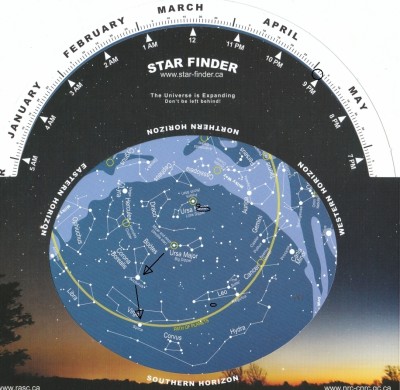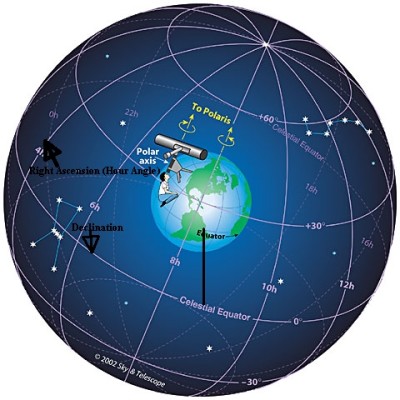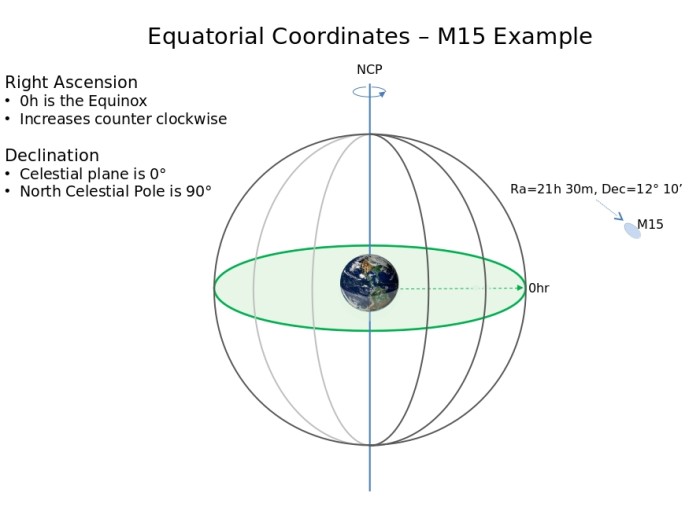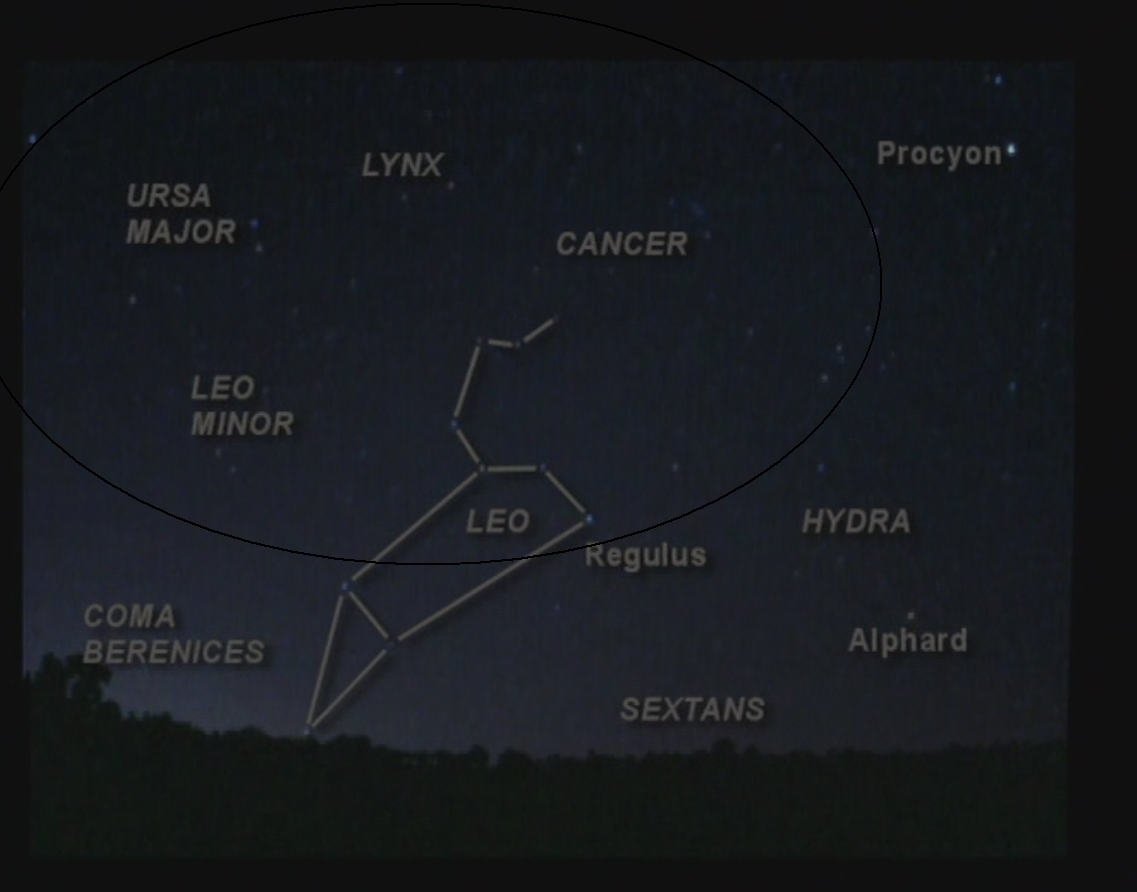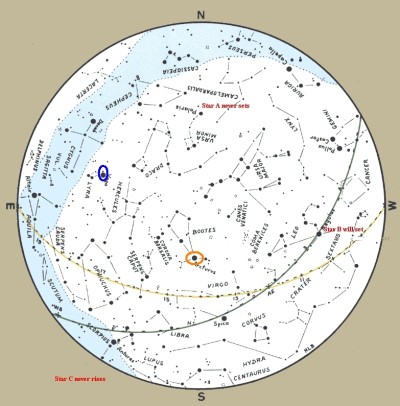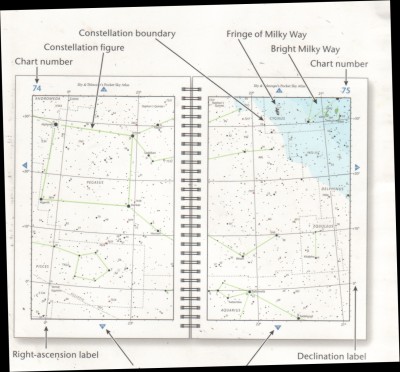Constellations proceed slowly from night to night
How to refer to objects in the sky? Over the course of a month, the same constellation (and the stars, clusters, and galaxies within those bounds) will rise 2 hours earlier by the end of the month.
Need a way to refer to an object’s location
Local Horizon Coordinates – Altitude-Azimuth Reference
- Earth based reference
- Altitude is the vertical angle from horizon
- Azimuth is the horizontal angle around the horizon with 0 as the geographic north
- Good for locating objects relative to current location and time – that’s how we use our planisphere
Alt-Az coordinates of celestial objects will change with time and location. Celestial Coordinates are used for locating stars on a fixed map.
Celestial Coordinates – Mapping Stars to their fixed Locations
Objects on the Celestial Sphere (– since last week have shifted to the West…Last week our planisphere showed constellation Leo just West of the Meridian, our
North-South line on which the stars culminate (reach highest elevation) when they are due South.
Now notice where Leo is…. It is starting to set in the West
Recall: What we see in the sky depends on
- Day in our orbit
- Latitude of the Observer – This sets the plane of the horizon. Recognizing that the altitude of the pole star is the same as our latitude will tell us the North/South boundaries of the celestial sky that we can see.
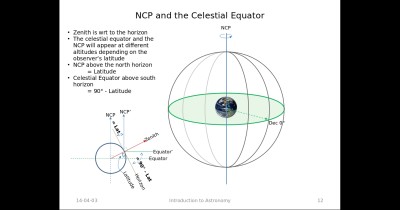
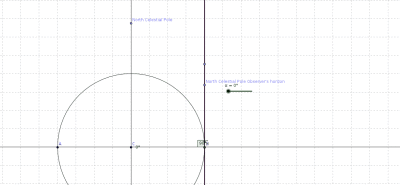
-animation courtesy P. Browne (Geogebra)
(You may have to click on the images to enlarge and see animation)
Stars are assigned celestial Coordinates of Right Ascension and Declination.For a given time of year, the Right Ascension and Declination of a Star will transit along the South Meridian.These coordinates are very similar to the earth coordinate system:
Right Ascension ~ Longitude
- RA is the angle around the celestial equator with 0 at the location of the Sun on the day of the vernal equinox. This zero location is similar to 0 Deg Longitude called the prime meridian on earth – the zero degree line at Greenwich England).
- The Celestial Prime Meridian is a fixed direction in space: the intersection between the celestial Equator line and the apparent annual pathway of the Sun and the planets which we call the Ecliptic.
Declination ~ Latitude . Very similar to earth degrees of Latitude
Locating what constellations are visible depends on the section of sky bounded by lines of Right Ascension are near our local Meridian for a given time of year. As we orbit the sun, we see different sections of sky, different constellations when the sun is below the horizon. At midnight in the fall for example our night sky pointer, points away from the Sun into deep space in the constellation of Andromeda.
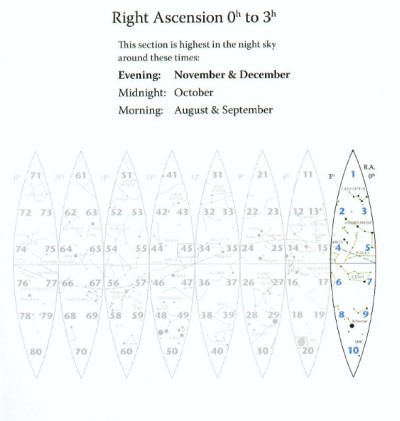
For a really complete guide to Right Ascension and Declination – visit our Calgary RASC site: http://calgary.rasc.ca/radecl.htm
Locating What Stars we see based on Sidereal or Star Time

Sidereal Time = A Day On Earth using Star Time
Sidereal Time = Hour and Day with respect to the Stars..(not the Sun)
- 1 Day = 1/365th of a circle about one degree
around the Sun. - Earth rotates on its axis as well as rotating around the sun.
- So, the time for a star to return to the same place in our sky the following evening is only 23 hours, 56 minutes and 4 seconds (not 24 hours)
This is called a Sidereal Day. It measures both Earth Rotation and Orbit with
respect to the stars
Understanding Star Time – Interval between Sidereal Days
- Point A on the second day is still looking at a parallel
direction in space . - However the star will appear at that spot in the sky 4
minutes of earth time earlier. - This corresponds to the amount of rotation taken up by
1440 (minutes/day) as the fraction 1/365
(orbit/day) So 1440/365 is roughly 4 minutes (shorter).
Spin around as we revolve… to reach the same position toward the stars at a ‘fixed’ infinite distance…
…then we spin around a bit further towards the center of our orbit … towards the sun.
‘We’re captive on a carousel of time. We can’t
return we can only look behind from where we came … and go
’round and ’round and ’round in the circle
game...’ J. Mitchell
The stars rise 4 minutes earlier each day because the earth has also moved through its orbit as it has rotated around from night to day to night. So now we see why Leo will rise 2 hours earlier at the end of the month: 4 mins x 30 days = 120 minutes or 2 hours.
Leo is an early Spring constellation and will rise and set earlier each night . In later spring, these stars will eventually set while it is still daylight.Constellation Leo will be followed by the summer constellation of Lyra (which contains the bright star Vega).
Celestial Objects rise in the East and set in the West
Apparent Motion of the Sky
Every night, stars rise and set… just as every day, the Sun, our star rises and sets… Because the Earth is turning and carrying the observer from West to East, the stars seem to be moving from East to West. What we see in the sky changes all the time because the earth is always rotating.
The Sun in the morning appears to rise in the East, At noon, it appears in the South (for our latitude) part of the sky. In the evening it is seen setting in the West.
- Similarly, you can see a bright star rise above the eastern
horizon in the early part of the night. At about midnight (middle of
the night ~ high noon for day) the star culminates. (rises highest)
in the southern part of the sky. When the night ends, and morning is
coming, the star will be setting in the western part of the sky. - The motion of the sky is called the apparent motion of the
sky because it is really we on the surface of the earth who are
rotating in this way.Courtesy Leo Enright, Sky Motion, The Beginner’s
Observing Guide
Star Positions throughout the Evening for a given Latitude
- Star A is could be a star in the Big Dipper
- Star B and C will eventually set below the horizon.
- Some Objects never rise above our Local Horizon as in (a)…It all
depends on where you, the Observer are standing on the earth.

- Star Motion – Image courtesy http://cseligman.com/text/sky/motions.htm
Using Star Maps
If you are not using the adjustable planisphere or a planetarium program, and just want to observe with star maps, you will need to use more than one over the course of the evening . Leo Enright has provided 6 star maps in The Beginning Observer’s Guide that show the sky for two months as a time. The one above is Map 3
For more detailed star maps, use maps that show details of areas according to Right Ascension . One example is the Pocket Sky Atlas:


